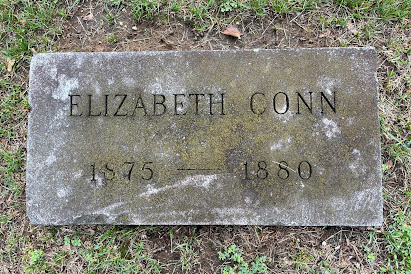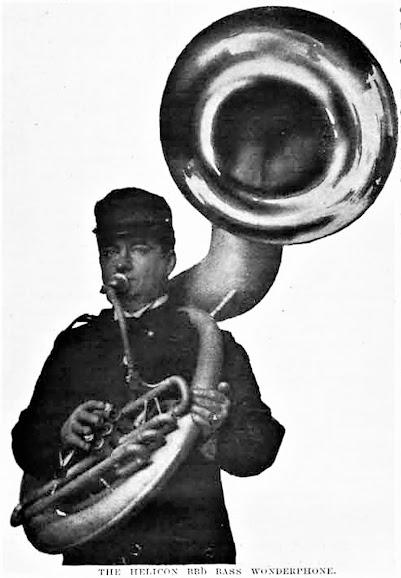My son and I, during our visit to Elkhart's Grace Lawn Cemetery at the end of June 2021
When you approach the Conn family plot, within Elkhart's Grace Lawn Cemetery, this is what catches your eye - a nine foot vertical slab of stone marking the final resting place of the former giant of a man, Charles Gerard Conn (1844-1931).
Conn was a huge figure in Elkhart, Indiana, beginning in the mid 1870s, when he started his band instrument business, and ending with his death in 1931 (although he had left Elkhart for good by 1916, after selling the company). The back of the slab reminds us of his remarkable life:
At the time he sold his company in 1915, he owned a great deal of land in and around Elkhart, as seen in this map from that year (the Conn factory is circled in red, and other chunks of land he owned are underlined in red; the cemetery in which he is buried is circled in yellow):
But you may have noticed that the towering stone that commemorates his death was erected by his "old employees and friends" at some point. Why? Where is the elaborate tombstone provided by Conn's legendary wealth? There is none. Instead, there is this simple in-ground gravestone, marking the fact that Conn passed away without much money to his name (how that came to be is a story for another time):
Conn was living in Los Angeles at the time of his death, and the January 6, 1931 edition of The Los Angeles Times ran this simple, but fascinating, death notice:
Suzanne Conn? Charles Gerard Conn, Jr.?! This was news to me!
The story of how and when Charles met and eventually married Suzanne is one that I am currently working on. But they had their son, Charles Jr., in 1918, when Conn was 74, which was four years before his first wife, Catherine, divorced him, after 52 years of marriage. Although, as I mentioned earlier, he had essentially abandoned Catherine in 1916, moving permanently to southern California.
And within a few weeks of that divorce being final in 1922, he married his long-time mistress out west (on their wedding day, Charles was 78 and Suzanne was 37). Curiously, while the divorce by Catherine is reported in a few newspapers, neither the birth of his son nor his second marriage is noted at all, as far as I have been able to find.
Meanwhile, Conn's remains were sent back to Elkhart, as reported in the January 9, 1931 edition of The Los Angeles Times:
Even though Conn was apparently living rather quietly during the last decade of his life, his passing was mourned throughout the country. Here is what was written in the January 7, 1931 edition of The Los Angeles Evening Express a day after his death (again, Conn had been living in Los Angeles for his final years):
Barely two years after his death, his widow (again, his second wife, Suzanne) and their son (who was actually 15 at that time) were destitute (these were, after all, the depression years), as revealed in the September 5, 1933 edition of The Los Angeles Record:
But back to Grace Lawn Cemetery in Elkhart, it is interesting to see Conn's simple gravestone somewhat off on its own, while there is a line of identical family gravestones that are together - a line that, surprisingly, doesn't include his first wife, Catherine, or the one child of theirs who grew to adulthood, Sallie (they are buried together in another part of the cemetery).
Here are the graves in that line of stones near Conn's stone:
His mother:
Here is the notice of her death in the September 10, 1884 edition of The Elkhart Daily Review:
His father:
Here's the notice of his death in the August 27, 1887 edition of The Elkhart Daily Review:
His only brother, who died in infancy (he also had two sisters: Florence Conn Dodge, 1846-1890; and Ella Conn Hagenbaugh, 1860-1934):
His first-born child, a son who was born somewhere around 1870-1873, but who only lived a few hours (thanks to Margaret Downie Banks of
the National Music Museum for this information):
His second child, "Lizzie," who was born to Charles and Catherine on February 28, 1874, and died before her third birthday, on October 28, 1876, which means the years on the gravestone are incorrect (thanks again to Margaret for this clarifying information):
The November 2, 1876 edition of The Elkhart Weekly Review ran this touching paragraph about Lizzie's passing:
His first wife's father:
Here's the notice of his death in the December 4, 1897 edition of
The Elkhart Weekly Review:
And his first wife's mother (which, again, is odd when you discover that his first wife, Catherine, is buried in an entirely different part of the cemetery!):
Here is her detailed obituary in the March 11, 1907 edition of The Elkhart Truth:
His third child, Sarah "Sallie" Katherine Conn, who, again, was their only child to live to adulthood, was born on September 4, 1877, as was briefly noted in that day's edition of The Elkhart Daily Review:
But, once again, she is buried in another part of the cemetery, along with her mother (block V in the northwest corner, according to Margaret). I learned about this after our visit, and so do not have photos of their gravestones.
Sallie's story is ultimately a sad one, as she struggled with mental health fairly early on in her life, and was institutionalized for many years before dying at age 53 - just a few months after her father passed away.
Here is her brief obituary, in the April 23, 1931 edition of The South Bend Tribune:
And as for Conn's second wife, whose maiden name was also Conn (her birth name was Mary Suzanne Conn, but Margaret clarified that she and Charles were not related) - she died in Los Angeles in 1960, as reported in the July 28 edition of
The Los Angeles Evening Citizen News:
Their son, Charles Gerard Conn Jr., died in 1996.
As often happens for me, this visit sparked an interest in learning more about Conn and his family history. Stay tuned for more posts in the near future!
[Special thanks to Tim and Meg Shelly for graciously escorting us to the Grace Lawn Cemetery following our visit to their home,
the Conn mansion, in Elkhart in late June.]


















































































